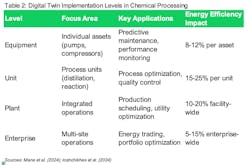Digital Transformation: Unlocking Energy Efficiency in Chemical Processes
Related Reading
Digital technologies are breathing new life into aging process plants, enabling operators to fine-tune energy consumption with a precision once reserved for greenfield sites. The journey is multifaceted, requiring cross-disciplinary teams and orchestration of both legacy and next-generation systems, but the rewards are significant: energy savings, cost savings, improved reliability and a smaller carbon footprint, all within “virtual” reach.
Recent studies from the European Chemical Industry Council indicate that digital technologies can reduce energy consumption by 15% to 25% across various processes while simultaneously improving product quality and operational safety. However, realizing these benefits requires more than technology deployment. It requires a fundamental shift in how plants approach data governance, workforce development and operational decision-making (Little et al., 2023).
Digital Twins: The Cornerstone of Energy Optimization
Digital twins have evolved from conceptual models to indispensable tools for energy management. A digital twin is a virtual replica of a physical or potential asset that integrates sensor data, computational models and control systems to simulate, predict and optimize its real-world counterpart. It is useful to conceptualize a three-tier implementation framework for the technology:
- Equipment-level twins monitor critical assets like reactors and compressors using vibration analysis and thermal profiling.
- Process-level twins simulate entire production lines, enabling closed-loop control of distillation columns.
- Enterprise-level twins integrate power and process systems across facilities.
Equipment-level digital twins are particularly valuable for protecting and ensuring high performance of critical instruments such as compressors, pumps, heat exchangers and reactors (Mane et al., 2024).
These digital twins collect and evaluate real-time data, including vibration levels and pressure and temperature. The insights gained from the virtual models enable early failure detection, operational setting optimization and timely interventions to reduce downtime. Case studies show heat-pump-assisted distillation optimized through digital twin modeling can reduce energy consumption by up to 70% in individual columns while maintaining product quality (Kiss & Smith, 2020).
Additionally, industry-standard tools can create dynamic simulations that correlate real-time feedstock variability with historical performance. These platforms, for example, can reduce steam consumption and predict fouling in heat exchangers with up to 99% accuracy (Huzaifa, 2023). This further reduces cost and energy across the lifetime of plant operations.
Digital Twin-Driven Energy Optimization
Digital twin technology has proven particularly effective in reducing energy consumption through virtual replication and simulation of physical systems. For example, in apatite-nepheline ore processing, digital twins utilizing deep neural networks achieved a 22% reduction in energy use by optimizing thermophysical and hydrodynamic processes in real time (Dli et al., 2020). These systems enable multichannel control over production parameters, allowing operators to test energy-saving strategies in a risk-free virtual environment before physical implementation. The technology's ability to predict equipment behavior under varying feedstock conditions has become critical for maintaining energy efficiency during material transitions.
The sophistication of digital twins continues to advance as computational capabilities improve. Modern implementations incorporate physics-based models with machine learning algorithms to create hybrid systems that combine first-principles understanding with data-driven insights. This approach is particularly valuable in chemical processing, where complex reactions and thermodynamic relationships must be accurately represented. Integration of these models with real-time sensor data enables continuous calibration and refinement, ensuring the digital representation is sufficiently aligned with physical reality despite changing process conditions.
Digital Technologies for Energy-Efficient Process Control Systems
Algorithms, such as machine learning, complement digital twins by identifying complex, non-linear relationships that traditional models might miss. These data-driven approaches learn directly from operational data, adapting to the specific conditions of individual facilities.
The virtual representations may offer advantages over traditional modeling techniques, including flexibility, accuracy and execution speed. These strengths make machine learning particularly valuable for energy-intensive operations, providing the computational foundation for real-time optimization and planning that require high accuracy. Machine learning algorithms have modernized traditional process control paradigms by enabling adaptive optimization of energy-intensive operations.
Neural networks trained on historical process data can identify non-intuitive relationships between control parameters and energy consumption (Dobbelaere et al., 2021, Mitrai & Daoutidis, 2025). For example, machine learning was trained at a refinery using over 950,000 historical data samples for top temperature, top pressure, reboiler volumetric flow, inlet temperature, and outlet temperature to develop real-time monitoring of crude oil distillation to ensure product quality and minimize energy (Rožanec et al., 2022).
Computing Challenges
Despite these benefits, implementation of digital technologies presents challenges. The quality and quantity of available data often limit model effectiveness, and many chemical facilities lack the specialized expertise required for development and maintenance. A significant challenge facing machine learning and now artificial intelligence adoption in the chemical industry is the risk of misuse, stemming from the fact that many chemical engineers have limited backgrounds in computer science and data analysis (Dobbelaere et al., 2021).
Additionally, key barriers remain in scaling digital energy optimization technologies as related to existing assets. Legacy control infrastructure often lacks the sensor density and connectivity required for advanced analytics, necessitating significant capital investment for retrofitting. The computational intensity of real-time optimization algorithms must also be considered, requiring a careful balance between energy savings and processing overhead. Solutions focused on edge computing architectures that distribute computational loads across networked devices, reducing central processing requirements while maintaining optimization fidelity often provide convincing fixes.
The Matrix to Success
Digital transformation is no longer optional for chemical plants targeting energy efficiency. By planning for incremental implementation, robust data foundations and workforce upskilling, operators can achieve immediate savings while building capabilities for long-term success. A full digital transformation must also consider critical topics related to digital twins, but not discussed here, such as prioritizing interoperability in legacy system upgrades and aligning electrification investments with renewable energy availability.
The most successful digital transformation initiatives are characterized by clear strategic alignment, executive sponsorship and systematic implementation approaches. They balance technological innovation with organizational change management, recognizing that sustainable performance improvements require advanced tools and evolved operational practices. Yet, regardless of where you are on your journey, digital technologies offer a compelling direction toward modernization and, when implemented correctly, are a no-regret pillar for energy-efficient operations.
References
Al Zami, M. B., Shaon, S., Quy, V. K., & Nguyen, D. C. (2025). Digital Twin in Industries: A Comprehensive Survey. IEEE Access.
Dobbelaere, M. R., Plehiers, P. P., Van de Vijver, R., Stevens, C. V., & Van Geem, K. M. (2021). Machine learning in chemical engineering: Strengths, weaknesses, opportunities, and threats. Engineering, 7(9), 1201-1211.
Dli, M., Puchkov, A., Meshalkin, V., Abdeev, I., Saitov, R., & Abdeev, R. (2020). Energy and resource efficiency in apatite-nepheline ore waste processing using the digital twin approach. Energies, 13(21), 5829.
Ghenai, C., Husein, L. A., Nahlawi, M. A., Hamid, A. K., & Bettayeb, M. (2022). Recent trends of digital twin technologies in the energy sector. Sustainable Energy Technologies and Assessments, 54, 102837.
Huzaifa, A. J. (2023, October). Predictive Maintenance of Heat Exchangers Using Digital Twin Models Systematic Literature Review. In Abu Dhabi International Petroleum Exhibition and Conference (p. D031S108R001). SPE.
Kiss, A. A., & Smith, R. (2020). Rethinking energy use in distillation processes for a more sustainable chemical industry. Energy, 203, 117788.
Little, A. D., Samoylova, M., Wilmet, S., Witthaut, D., & Kolk, M. (2023). Digital technologies for sustainability in the european chemical industry. Cefic.
Ioshchikhes, B., Frank, M., & Weigold, M. (2024). A systematic review of expert systems for improving energy efficiency in the manufacturing industry. Energies, 17(19), 4780.
Mane, S., Dhote, R. R., Sinha, A., & Thirumalaiswamy, R. (2024). Digital twin in the chemical industry: A review. Digital Twins and Applications, 1(2), 118-130.
Mihai, S., Yaqoob, M., Hung, D. V., Davis, W., Towakel, P., Raza, M., ... & Nguyen, H. X. (2022). Digital twins: A survey on enabling technologies, challenges, trends and future prospects. IEEE Communications Surveys & Tutorials, 24(4), 2255-2291.
Mitrai, I., & Daoutidis, P. (2025). Accelerating process control and optimization via machine learning: A review. Reviews in Chemical Engineering, 41(4), 401-418.
Rožanec, J. M., Trajkova, E., Onat, M. K., Sarantinoudis, N., Arampatzis, G., Fortuna, B., & Mladenić, D. (2022, July). Machine-learning-based soft sensors for energy efficient operation of crude distillation units. In 2022 International Conference on Electrical, Computer and Energy Technologies (ICECET) (pp. 1-6). IEEE.
About the Author
Thomas Kwan
Global Vice President, Strategic Innovation and Industrial Ecosystems
Thomas Alan Kwan is an energy transition expert at Schneider Electric's Sustainability Research Institute. With a Ph.D. in chemical and environmental engineering, he brings a blend of academic rigor and industrial experience to the field of sustainable manufacturing and green engineering.
At Schneider Electric, he leads initiatives focused on new and emerging industrial systems, with a particular emphasis on the chemical processing sector. His work involves developing innovative solutions and practices to drive energy, environmental and economic benefits.
Previously, he was a key member of Unilever's product engineering team, where he integrated green chemistry and engineering principles for product and process development. His contributions earned him a lifetime honorary membership on the team. Kwan also has experience in environmental regulation, having worked with the U.S. EPA on Clean Water Act programs.
Through his research and collaborations, Kwan continues to explore innovative ways to reduce energy consumption, minimize waste, maximize value and improve overall process efficiency in chemical manufacturing operations.



